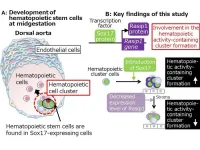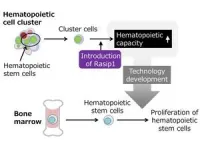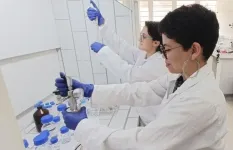The origins of blood: Researchers identify a gene critical to blood production
2023-09-13
(Press-News.org)
Researchers from Tokyo Medical and Dental University (TMDU) have discovered that a gene called Rasip1 is intimately involved in the creation of blood cells
Tokyo, Japan – Blood has long been a symbol of life and health, so it may be surprising that some aspects of blood production, i.e., hematopoiesis, remain incompletely understood. One such mystery is the role of a protein called SOX17. Blood cells are generated by hematopoietic stem cells (HSCs), and SOX17 seems to be important to the development of HSCs because SOX17 is expressed where HSCs first develop. What exactly SOX17 does, however, has remained unclear.
Now, a research team at Tokyo Medical and Dental University (TMDU) has discovered just that, revealing that SOX17 targets a gene called Rasip1. To appreciate their research achievement, we first need to know a little more about SOX17 and the origins of blood.
SOX17 is a ‘transcription factor’, a special type of protein that regulates the activities of genes and whether genes are active at any given time. SOX17 is expressed in clusters of cells in a blood vessel called the dorsal aorta; these clusters, called ‘intra-aortic hematopoietic cell clusters’, are where HSCs first develop in mice, around embryonic day 10.5. The researchers aimed to determine SOX17’s role in these clusters.
To investigate potential targets of SOX17, the team first carried out RNA-sequencing analysis to see which genes were activated in two very similar populations of cells, one expressing SOX17 and one not.
“One gene that stood out during RNA-sequencing analysis was Rasip1,” explains first author Gerel Melig. “This gene is known to be a regulator in vascular cells, which line the blood vessels.”
The research team therefore investigated Rasip1 further. They showed that SOX17 binds to the enhancer element of the Rasip1 gene to activate it, and then analyzed the effects of both knocking down and overexpressing the gene. Rasip1 knockdown and subsequent loss of activity resulted in fewer clusters of cells with hematopoietic activity, whereas Rasip1 overexpression increased hematopoietic activity.
“We therefore have proposed a model of early hematopoiesis, in which SOX17 induces the expression of Rasip1, leading to the development of HSCs and associated hematopoietic activity in intra‑aortic hematopoietic cell clusters,” says senior author Tetsuya Taga.
This study increases our understanding of the early stages of hematopoiesis. This process, forming all cellular components of blood, occurs not only during embryonic development but also throughout adulthood, producing and replenishing the blood cells in the body. A greater understanding of the mechanisms and molecules involved will enhance our knowledge of the processes underlying disorders and cancers of the blood.
###
The article, “A SOX17 downstream gene Rasip1 is involved in the hematopoietic activity of intra-aortic hematopoietic clusters in the midgestation mouse embryo,” was published in Inflammation and Regeneration at DOI: 10.1186/s41232-023-00292-4.
END
[Attachments] See images for this press release:


ELSE PRESS RELEASES FROM THIS DATE:
2023-09-13
COLUMBUS, Ohio – A new type of analysis suggests that droughts in Ohio were more severe from 2000 to 2019 than standard measurements have suggested.
Researchers at The Ohio State University developed impacts-based thresholds for drought in Ohio, looking specifically at how corn yield and streamflow were affected by various drought indicators, such as notable changes in soil moisture, crops, and even livestock losses in the state.
The results suggest this impacts-based approach could give Ohio farmers earlier and more accurate notice when drought conditions are approaching, said Steven Quiring, co-author of the study and a professor ...
2023-09-13
Men ages 50 to 60 have an 80 percent chance of having some degree of bladder outlet obstruction (BOO) due to an enlarged prostate – which causes multiple symptoms that can impact their lives physically and psychologically.
The bladder, an incredibly complex organ, has its own electrical system and can change its constituents and geometry through a growth and remodeling process. However, in bladders with BOO, the urethral resistance increases and forces the muscle cells within the bladder to generate larger pressures to void. Over time, the bladder adapts with a growth and remodeling response that causes changes in bladder size, tissue composition, ...
2023-09-13
The EU Horizon 2020 project B-GOOD, aiming at improving honey bee health and beekeeping sustainability, invites participants to the project’s closing conference in Bled, Slovenia this October. The upcoming scientific event will feature oral presentations, poster sessions, and information market stands to provide a comprehensive overview of the results and technologies developed during the project. The attendees will also be able to meet the consortium members of the project, ask questions and exchange ideas.
The event will take place on the 2nd of October 2023 immediately before the COLOSS ...
2023-09-13
New research suggests that owls in Texas have high rates of anticoagulant rodenticides (AR)—blood thinning rat poisons—in their systems. Jennifer Smith, a professor of integrative biology in the UTSA College of Sciences, co-authored a research article published recently in PLOS ONE, the world’s first multidisciplinary open access journal.
Eres Gomez, M.S. ’22, a UTSA graduate who had conducted research in the Smith Wildlife Lab as a student, was the article’s lead author. Heather Prestridge, a curator ...
2023-09-13
Acetone is an essential chemical industry input and is used in the manufacturing of a wide array of products, such as adhesives, antibiotics, electronic components, solvents and removers, inks and vitamins, among others. Its production is complex and hazardous. To simplify the process and make it safer and cheaper, researchers in Brazil and Germany have developed an innovative method that uses only light and photoactive iron chloride (FeCl3), an inexpensive chemical compound.
An article on the research, which was funded by FAPESP, is published in the ...
2023-09-13
Oak Ridge National Laboratory scientists studied hot springs on different continents and found similarities in how some microbes adapted despite their geographic diversity. The findings yield clues to the evolution of life and whether some of the hardiest microbes may be harnessed for biotechnology.
The study was the first of its kind to sample hot springs on three continents with water temperatures above 65 C (149 F) in the United States, Iceland and Japan. The environments have unique geology and chemistry, almost like a fingerprint, so it was surprising to find highly related microbes separated by thousands of miles, said ORNL’s Mircea Podar, co-lead of the ...
2023-09-13
WASHINGTON — Most coastal communities will encounter 100-year floods annually by the end of the century, even under a moderate scenario where carbon dioxide emissions peak by 2040, a new study finds. And as early as 2050, regions worldwide could experience 100-year floods every nine to fifteen years on average.
A 100-year flood is an extreme water level that has a 1% chance of being exceeded in any given year and is based on historical data. Despite the name, 100-year floods can strike the same area multiple years in a row or not at all within a century. But a new study finds that those historical trends will no ...
2023-09-13
A new study from North Carolina State University and Duke University offers insights into the ways that education, work and motherhood shape the lives of women in the United States. In a longitudinal study of more than 8,100 women, the researchers found seven “pathways” that illustrate the way major life events can have long-term ripple effects.
“Our goal here was to examine how family, work and education influence each other in the lives of women, rather than viewing education as a separate process from work and family,” says Anna Manzoni, co-author of a paper on the study and an associate professor of sociology ...
2023-09-13
“Cosmologists believe that only about 20% of the total matter is made of regular or ‘baryonic’ matter, which includes stars, galaxies, atoms, and life,” explains first author Dr. Mohamed Abdullah, a researcher at the National Research Institute of Astronomy and Geophysics-Egypt, Chiba University, Japan. “About 80% is made of dark matter, whose mysterious nature is not yet known but may consist of some as-yet-undiscovered subatomic particles.” (Fig. 1)
“The team used a well-proven technique to determine the total amount of matter in the universe, ...
2023-09-13
The University of Chicago will launch a pioneering new center aimed at shifting the popular narrative around the physical and cognitive impacts of aging.
Headed by leading neuroscientist Emily Rogalski, PhD, the new University of Chicago Healthy Aging & Alzheimer's Research Care (HAARC) Center will focus on building deep multidisciplinary expertise and bridging the gap between scientific disciplines to accelerate breakthroughs in cognitive resilience.
“We want to increase awareness and the scientific probability ...
LAST 30 PRESS RELEASES:
[Press-News.org] The origins of blood: Researchers identify a gene critical to blood production







